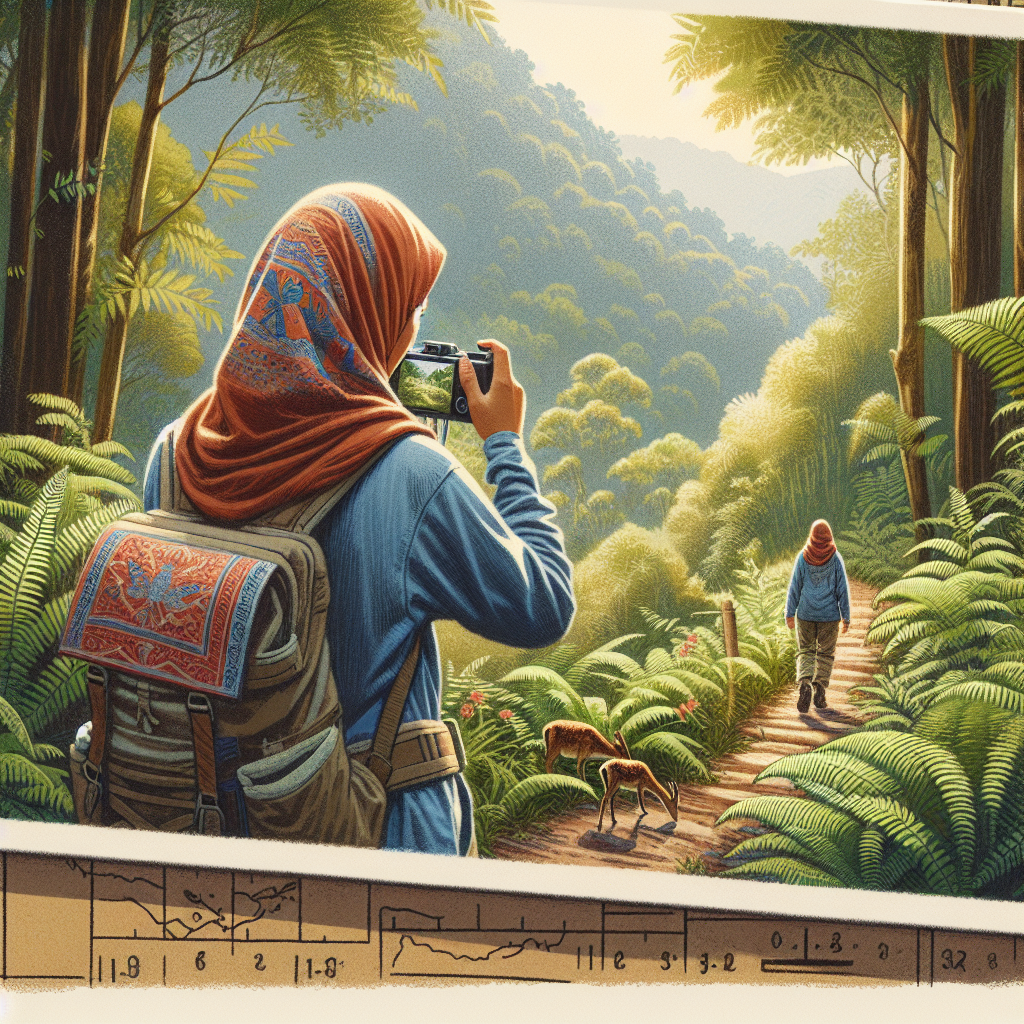In the great expanse of nature, where you become a part of an ecosystem full of diverse flora and fauna, different elements, and vast landscapes, a set of guidelines helps to maintain this delicate balance. Your passion for hiking may lead you to some awe-inspiring sights and unforgettable experiences; however, along with the thrill of exploration, it also brings certain responsibilities. In “Trail Etiquette: Respectful Hiking Practices,” you will learn the intricate ‘dos and don’ts’ of hiking ethics, from leaving no trace, to respecting wildlife and other hikers, to ensuring you’re always acting as a responsible steward of the environment. So, gear up and get ready to learn how to enjoy nature responsibly, protect our green spaces, and join the ranks of respectful hikers worldwide.

Understanding the Importance of Trail Etiquette
When you venture out into the great outdoors, trail etiquette is a crucial aspect of your adventure. It’s a set of guidelines that ensure everyone can enjoy their experience in nature while staying safe and preserving natural environments.
Social implications of trail etiquette
Trail etiquette goes beyond merely ensuring personal safety; it encompasses the wider social implications as well. On a basic level, it means respecting the privilege of sharing space with others. For instance, greeting fellow hikers with a friendly nod helps foster a positive community atmosphere. Equally important is giving way to other hikers when necessary, and keeping noise levels low to avoid disturbing others’ enjoyment of the surroundings.
Environmental impact of good hiking practices
Trail etiquette has a significant impact on our environment as well. By sticking to marked trails, you help prevent soil erosion and protect vegetation and wildlife habitats. It also involves practicing Leave No Trace principles, such as carrying out whatever you bring in, not feeding wildlife, and avoiding harm to plants and natural features.
Safety considerations for etiquette on trails
Safety comes first when hiking, and proper trail etiquette plays a key role in ensuring everyone’s well-being. For instance, making sure faster hikers can pass safely, using designated trails, and keeping pets on a leash are part of good hiking safety etiquette. Also, knowing beforehand who has right of way on the trail can help prevent accidents and misunderstandings.
Practicing Leave No Trace Principles
The Leave No Trace philosophy is a set of guidelines aimed at preserving the natural beauty of our landscapes while minimizing our ecological footprint.
Understanding the Leave No Trace philosophy
At its core, Leave No Trace means that hikers should strive to leave as little impact on the environment as possible. It’s about respecting nature and doing your part to ensure future generations can enjoy it too.
Proper waste management on trails
Using a simple principle like “Pack it in, pack it out,” you can effectively manage waste during your hike. This means that all litter, including organic waste like fruit peels or nut shells, should be taken with you when you leave.
Respecting wildlife and natural resources
Another facet of Leave No Trace is showing respect for wildlife by observing from a distance and not feeding or disturbing them. Also, it’s important not to pick flowers, pull bark off trees, or otherwise disturb natural resources.
Yielding and Right of Way Rules
Knowing when to yield or who has the right of way on the trail helps ensure smooth passage for everyone involved and helps prevent conflicts or accidents.
How to determine who has the right of way
Typically, uphill hikers have the right of way because maintaining a steady rhythm can be more challenging when climbing. However, some uphill hikers may prefer to take a break and let you pass, so communication is key.
Special considerations for bikers, horseback riders, and hikers
There are special considerations depending on the type of trail user. For example, bikers should yield to both hikers and horseback riders. Hikers, in turn, should yield to horseback riders.
Navigating crowded trails respectfully
On crowded trails, it’s important to treat others with respect and kindness. Be aware of your surroundings, step aside to allow faster hikers to pass, and keep noise to a minimum.
Proper Trail Usage and Maintenance
Utilizing and maintaining trails correctly helps prolong their lifespan and maintain their natural beauty and functionality.
Sticking to marked trails to prevent erosion
By sticking to marked trails, you can help prevent soil compaction and erosion, which can harm plant life and degrade water quality.
Carrying out what you carry in
It’s crucial to pack out what you pack in, whether it’s food packaging, water bottles, or other garbage. Leaving these behind can harm wildlife and spoil the natural beauty of the trail for others.
Helping maintain trail integrity and cleanliness
Everyone can play a part in maintaining the trail by picking up any litter they come across, even if it’s not yours. You might also consider participating in trail clean-ups or other volunteer opportunities in your area.

Noise Control on Trails
Control of noise on trails is crucial not only for the peace and enjoyment of other hikers but also for the well-being of wildlife.
The impact of excessive noise on wildlife
Excessive noise can drive wildlife away, disrupt their behaviors, and make them more susceptible to predators. By keeping noise levels low, you’re showing respect for their home and contributing to the preservation of wildlife populations.
The benefits of peaceful, quiet trails to other hikers
Quiet trails allow hikers to better connect with nature, observe wildlife in their natural habitat, and simply enjoy the peacefulness of the outdoors, contributing to a more fulfilling hiking experience.
How to keep noise levels low
To keep noise levels low, avoid shouting, keep music in headphones, and instruct children about the importance of being quiet on the trails.
Managing Pets on Trails
Taking care and control of pets on trails is another aspect of good trail etiquette.
Leash laws and pet control
Many trails have leash laws to ensure the safety of both pets and wildlife. Even in areas where leashes aren’t required, it’s best to keep your pets under control to prevent them from disturbing wildlife or other hikers.
Picking up after your pet
Always clean up after your pet. Pet waste can transmit disease to wildlife, contaminate water sources, and detract from the natural beauty and enjoyment of trails for other hikers.
Tips for hiking with dogs
Take plenty of water for your dog, avoid hiking during the hottest time of day, and be aware of the trail’s terrain and length so you don’t exceed your dog’s physical limits.
Consideration for Other Hikers
Showing consideration towards fellow hikers can elevate everyone’s trail experience.
Respecting personal space and peace
Respect others’ personal space by not crowding them on the trail or at viewpoints. Keep conversations and noise levels low to maintain a peaceful environment.
Helping fellow hikers in need
If you come across a hiker in need, offering to help reflects good trail etiquette. Whether it’s lending a band-aid or showing the way back to the trail, every little help goes a long way.
Group hiking etiquette
If you’re hiking in a group, try to keep the size to a minimum to limit your environmental impact and noise levels. Also, ensure your group yields to single or pair hikers.
Food and Drink Etiquette on the Trail
What you choose to eat and drink on the trail, and how you do it, can have an impact on the environment and other trail users’ experiences.
Why not to feed wildlife
While it may seem harmless or even kind, feeding wildlife actually does more harm than good. It can interfere with animals’ natural behaviors, potentially leading to problematic human-wildlife interactions.
Carrying out all food and drink waste
Any scraps, peels, or containers need to be packed out with you to ensure you’re not leaving behind potential litter that could harm wildlife or spoil the experience for other hikers.
Safe & eco-friendly trail snacking
Consider repackaging snacks at home to minimize waste on the trail. Opt for eco-friendly packaging whenever possible, and choose snacks that won’t spoil or attract animals if accidentally dropped.
Camping Etiquette on Hiking Trails
Overnight camping requires a heightened level of responsibility and etiquette to ensure you’re not leaving any negative impacts behind.
Choosing appropriate camping spots
Cri sibly.
Keeping campsites clean
Remember the Leave No Trace principle when camping. Keep your campsite clean, storing food properly to avoid attracting wildlife, and pack out all trash when you leave.
Minimizing campfire impact
When having a campfire, follow established guidelines on size and safety. Use existing fire rings where possible, keep your fire small, and always extinguish it completely before leaving.
Hiking in Special Conditions
Hiking in different seasons or during particular times of day requires an extra level of awareness and etiquette.
Winter hiking etiquette
Winter hiking brings additional challenges, such as navigating snow-covered trails, requiring extra care. Keep to the marked paths and avoid walking on cross-country ski tracks.
Navigating trails during hunting season
During hunting season, stay safe by wearing bright, visible colors and sticking to designated trails. If you come across hunters on the trail, give them space and continue on your way.
Hiking during dusk or dawn times
Hiking at these times means you might encounter more wildlife. Always give animals the right of way and keep a respectful distance.
Dealing with difficult weather conditions
Weather can change quickly out on the trail. Storms, heat, or cold can all pose challenges. Always check the weather before leaving and make sure you’re prepared for changes.
By following these trail etiquette guidelines, you can ensure a pleasant, safe, and respectful experience for yourself, other hikers, and the natural world around you. Happy hiking!

